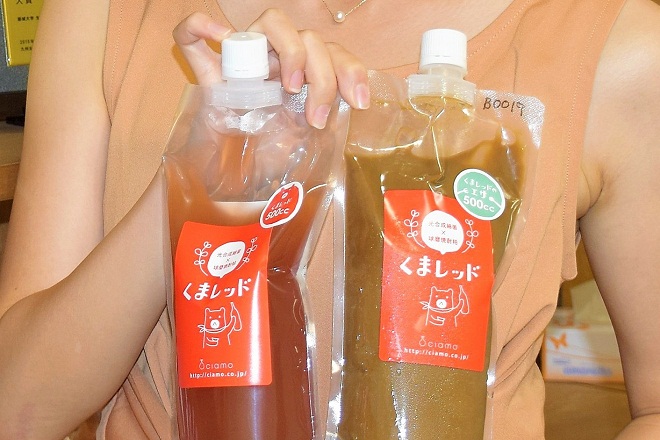Kumamoto Students Develop Fertilizers from Shochu Remnants
August 17, 2018
Kumamoto- Students in Kumamoto have developed a low-cost method to culture photosynthetic bacteria, which work as fertilizer, using distillation remnants of "shochu" spirits.
The developers, led by Aoi Koga, 24, a second-grader of Sojo University's Graduate School of Engineering in the southwestern Japan city, hope to help farmers cut their use of chemicals and distillers save money for disposing of the liquid remnants called "shochu kasu."
In 2016, Koga produced a liqueur targeting young women in collaboration with a distiller of rice-based Kumajochu shochu, a specialty of the Hitoyoshi Kuma area in Kumamoto Prefecture.
At that time, she realized that disposing of shochu kasu left after the distillation of mash made from fermented rice costs a total of 400 million yen a year at 28 distillers.
Launching research in April the same year, Koga found that the distillation remnants contain rich citric acid suitable for culturing photosynthetic bacteria.
She and other students kept trying to find how to culture the bacteria with shochu kasu while receiving advice from Prof. Hitoshi Miyasaka, their mentor and a photosynthetic bacteria expert.
As a result of the research, which continued for about a year, Koga's team discovered conditions for stable culturing of the bacteria, which produce various effects such as a harvest increase and quality improvement, depending on crops.
In April this year, Koga established a startup called Ciamo with three others to make and sell a photosynthetic bacteria culture kit, which contains the bacteria and shochu kasu-based broth.
Ciamo was able to set the price of the kit, dubbed "Kuma Red," at about half the prices of similar products thanks to the use of the low-cost culture material.
The kit has been already sold to some 40 farmers mainly in the prefecture. The company aims to achieve sales of 300 million yen in the coming three years.
It is estimated that if a rice farmer adopts photosynthetic bacteria, its profit would rise about 90,000 yen per 1,000 square meters of field thanks to a decline in the use of chemical fertilizers and a rise in crop production.
Shochu producers also welcome the development of the method to recycle the distillation residues, because disposing of them, designated as industrial waste, is costly, the head of Toyonaga Shuzo, a distiller in the town of Yunomae, said.
Expressing hope to expand into overseas markets, Koga, who serves as president of Ciamo, said, "We're eager to use the power of microbes to reduce the use of pesticides and chemical fertilizers, even if only slightly." Jiji Press
Latest Videos
- THE UNTOLD STORY EXPERT INSIGHTS INTO THE UKRAINE
- NEGOTIATING A NEW ORDER US RUSSIA TALKS ON UKRAIN
- Ukraine: A Pawn in the Geopolitical Game? Will Trump Intervene?
- US VP VANCE CRITICIZES EUROPEAN DEMOCRACIES AT MUNICH SECURITY CONFERENCE
- UNCOVERING THE WEB OF DECEIT: CIA INFILTRATION OF THE MEDIA
- SHIFTING SANDS: TULSI GABBARD’S CONFIRMATION AND THE EVOLVING GLOBAL LANDSCAPE
- FAUCI SCANDAL: A THREAT TO GLOBAL HEALTH AND DEMOCRACY






